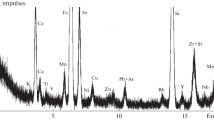Abstract
Results of works on estimating the environmental hazard classes of ashes and slags from power-generating facilities are presented. It is determined that the overwhelming majority of ashes and slags from power stations can be related to nonhazardous materials, which can be used as secondary raw mineral stock in producing construction materials.
Similar content being viewed by others
References
The Temporary Classifier of Toxic Industrial Wastes and Methodical Recommendations for Determining the Toxicity Class of Industrial Wastes. Approved by the Soviet Union’s Ministry of Public Health and the Soviet Union’s Committee for Science and Engineering on May 13, 1987.
Basic Rates of Charge for Emissions, Discharges of Polluting Substances into the Environment, and Disposal of Wastes. Approved by the Ministry of the Russian Federation for Natural Resources on November 27, 1992.
B. L. Vishnya and V. L. Shul’man, “Estimating the Toxicity of Ashes and Slags from Thermal Power Stations,” in Matters Concerned with Establishing Standard-Methodical and Technological Base for Nature Protection Activities in Power Engineering (UralORGRES, Yekaterinburg, 1997) [in Russian].
R. V. Borisenkova, E. P. Dik, L. A. Lutsenko, and A. N. Soboleva, “Estimating the Hazard from Ash and Slag Wastes Produced by the Ulan-Ude Cogeneration Stations,” Meditsina Truda, Prom. Ekol., No. 4, 8–13 (2004).
“About Production and Consumption Wastes,” Federal Law No. 89-FZ of June 24, 1998, in Collection of Legislation of the Russian Federation, No. 26, Article 3009, 1998.
“Criteria for Relating Dangerous Wastes to Classes of Hazard for the Environment,” Vtorichn. Resursy, Nos. 3–4 (2001).
FR (Federal Register) 1.39.2007.03222: Determining the Toxicity of Water and Water Extracts from Soils, Effluent Water Sediments, and Wastes from the Death Rate of Daphnids and Change of Their Fertility.
FR (Federal Register) 1.39.2007.03223: Determining the Toxicity of Water and Water Extracts from Soils, Effluent Water Residues from the Change in the Chlorophyll Fluorescence Level and Number of Algae Cells.
FR (Federal Register) 1.39.2007.04104 PND F T 16.312-07: A Procedure for Determining the Toxicity of Ash and Slag Wastes Using the Biological Test Method Based on the Survivability of Paramecia and Ceriodaphnids.
Methodical Guidelines for Taking Samples and Calculating the Component Composition of Ash and Slag Wastes from Thermal Power Stations and Boiler Houses. Approved on April 14, 2008 (RAO UES of Russia, Moscow, 2008) [in Russian].
SP (Sanitary Code) 2.1.7.1386-03: Sanitary Rules for Determining the Hazard Class of Toxic Wastes from Production and Consumption. Approved by the Chief Health Officer of the Russian Federation on June 16, 2003.
P. I. Kuznetsov, “Calculation Methods for Determining the Hazard Class of a Waste,” Ekol. Proizv., No. 3, 68–73 (2007).
H. Y. Foerborn, “Coal Ash in Europe: Properties and Utilization,” in Proceedings of the 2nd International Scientific-Practical Seminar “Ashes and Slags from Thermal Power Stations: Removal, Transportation, Reprocessing, and Stockpiling, April 23–24, 2009, pp. 20–30.
Minerals and Rocks in the Soviet Union (Mysl’, Moscow, 1970) [in Russian].
I. A. Korobetskii and M. Ya. Shpirt, Genesis and Properties of Mineral Coal Components (Nauka, Novosibirsk, 1988) [in Russian].
V. A. Kovda, Fundamentals of Soil Science (Nauka, Moscow, 1973) [in Russian].
GOST (State Standard) 25818-91: Fly Ashes from Thermal Power Stations for Making Concretes. Technical Specifications.
G. V. Voitkevich, A. E. Miroshnikov, A. S. Povarennykh, et al., A Handbook on Geochemistry (Nedra, Moscow, 1990) [in Russian].
V. V. Dokuchaev, Works on Studying Soils and Assessing Earths, and Science of Soil Zoning and Classification (USSR Acad. Sci., Moscow-Leningrad, 1951), Vol. VI.
E. P. Dik and A. N. Soboleva, “The Hazard Class of Ash and Slag Wastes Produced at Thermal Power Stations from Firing Kuznetsk Coals,” Elektr. Stn., No. 1, 9–13 (2006).
I. Ya. Zalkind, V. S. Vdovchenko, and E. P. Dik, Ash and Slags Produced in Boiler Furnaces (Energoatomizdat, Moscow, 1988) [in Russian].
“About the Charge Rates for Emissions of Polluting Substances Discharged into the Atmospheric Air by Stationary and Mobile Sources, Discharges of Polluting Substances into Surface and Underground Water Bodies, and Placement of Production and Consumption Wastes,” Decree of the Russian Federation Government No. 334 of June 12, 2003 (in the formulation of the Decree of the Russian Federation Government No. 410 of July 1, 2008 with changes introduced according to the Decree of the Russian Federation Government No. 7 of January 8, 2009).
Author information
Authors and Affiliations
Additional information
Original Russian Text © E.P. Dik, A.N. Soboleva, O.A. Smirnova, 2011, published in Teploenergetika.
Rights and permissions
About this article
Cite this article
Dik, E.P., Soboleva, A.N. & Smirnova, O.A. Environmental hazard classes of ashes and slags from thermal power stations. Therm. Eng. 58, 506–512 (2011). https://doi.org/10.1134/S0040601511060024
Published:
Issue Date:
DOI: https://doi.org/10.1134/S0040601511060024




